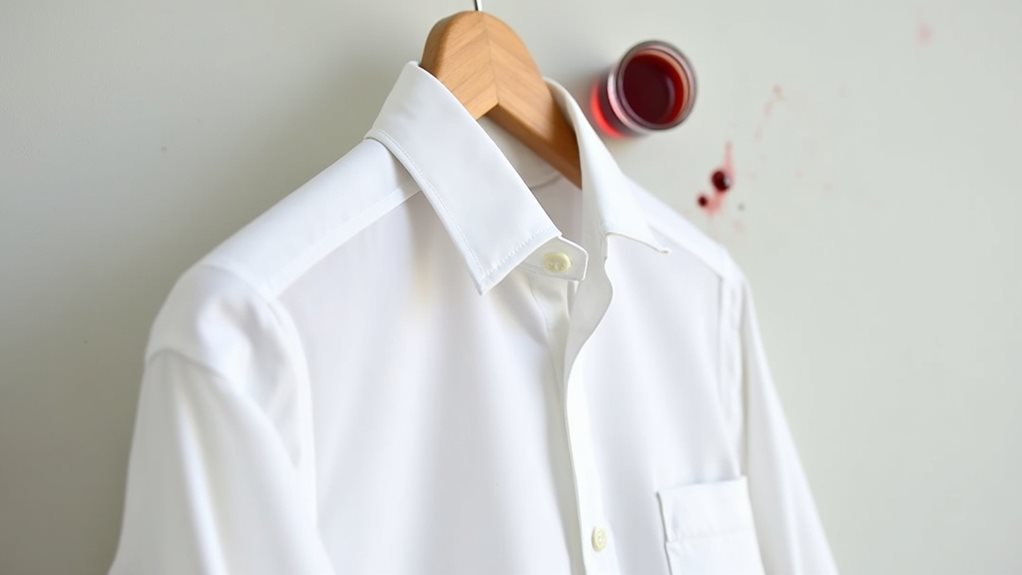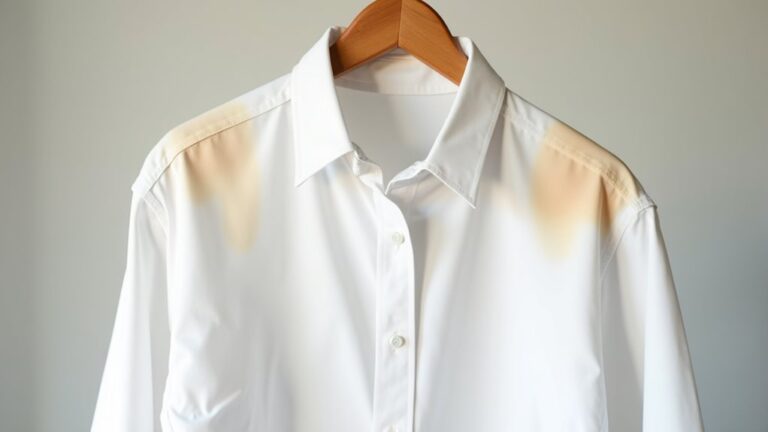Yes, dry cleaning can effectively remove most blood stains from your clothes, especially when you act quickly and bring them to professionals who know their craft. Fresh blood responds much better than set-in stains, since those stubborn spots have already bonded with the fabric fibers. Professional cleaners use specialized enzyme treatments that literally digest blood proteins at the molecular level, combined with non-water solvents that won’t push stains deeper into delicate fabrics like silk or wool. There’s more to this process than meets the eye.
How Dry Cleaning Removes Blood Stains From Fabric
When you’re staring at a blood stain on your favorite silk blouse or wool suit, you might wonder if dry cleaning can actually tackle something that seems so permanent and stubborn.
That seemingly permanent blood stain on your precious silk or wool doesn’t have to spell disaster for your favorite garment.
Here’s the thing – professional dry cleaners have become masters at conquering these protein-based nightmares using specialized stain treatments that you simply can’t replicate at home.
Their dry cleaning service employs enzyme-based spot cleaners that literally digest the blood proteins, breaking them down at a molecular level before they can set permanently into your delicate fabrics.
Unlike water-based cleaning that can actually push blood deeper into fibers, non-water solvents dissolve those organic compounds effectively.
The key is acting quickly and being honest with your cleaner about what happened – they’ve seen it all! 😊
However, the success rate varies significantly depending on factors like the age of the stain and type of fabric involved.
Fresh Blood Stains vs. Set-In Blood Stains: What Makes the Difference
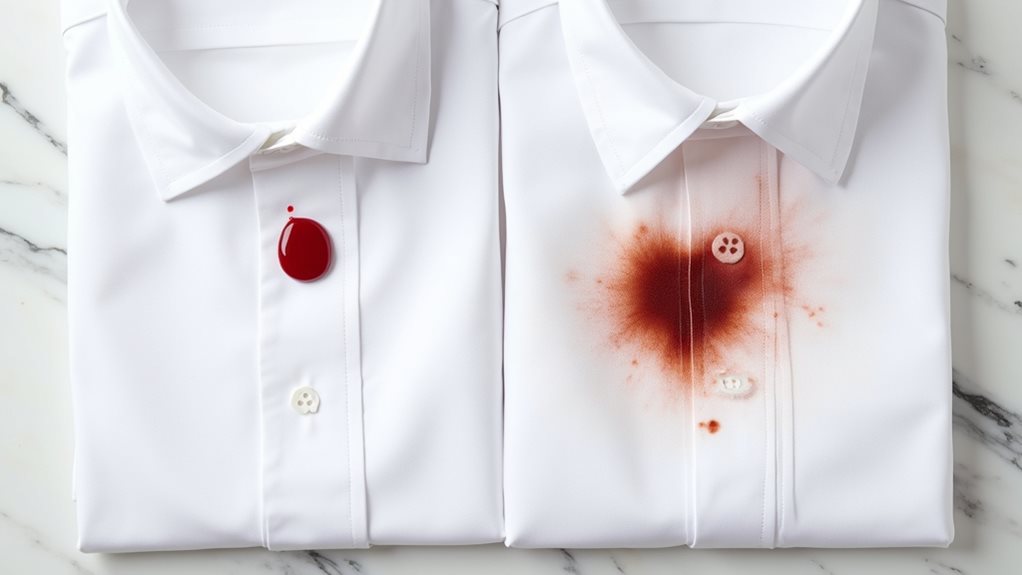
Although I’ve learned this lesson the hard way after ruining more than one favorite shirt, the timing of when you address a blood stain makes all the difference between complete removal and a permanent reminder of your mishap.
Fresh blood stains haven’t bonded with fabric fibers yet, making them considerably easier for dry cleaners to tackle with their enzyme-based treatments that break down protein-based stains effectively.
Set-in blood stains, however, become stubborn opponents that resist even specialized treatments, greatly reducing your success rate for complete stain removal.
The longer you wait, the more that blood becomes one with your fabric, which is why I always rush to my dry cleaner immediately after any accident, explaining exactly what happened and when.
Professional dry cleaners use specialized solvents specifically formulated to tackle protein-based stains that regular water-based cleaning methods often can’t handle effectively.
Dry Cleaning Methods and Solvents Used for Blood Removal
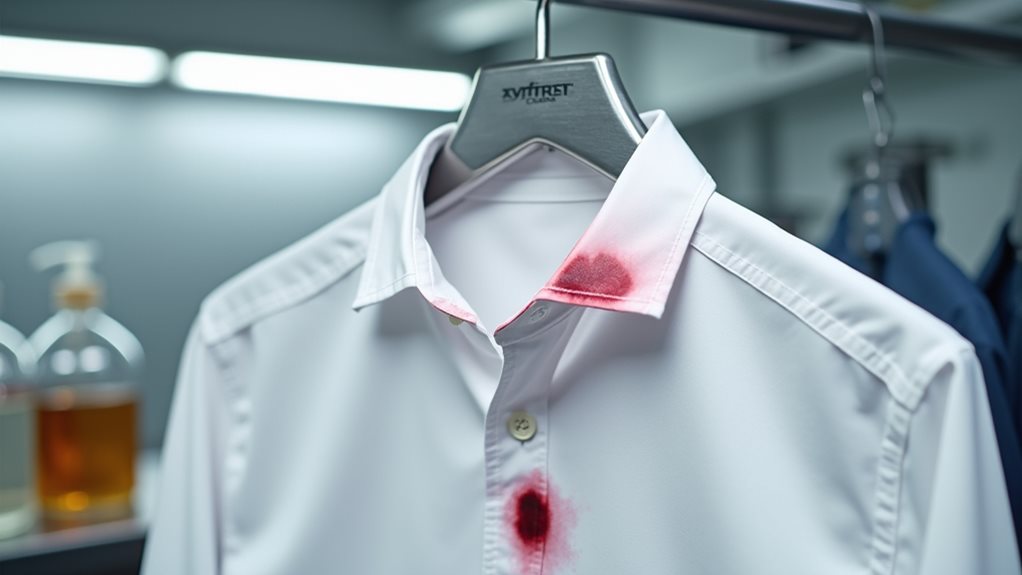
When you’re facing a stubborn blood stain, professional dry cleaners have three main weapons in their arsenal that work like magic, and understanding these methods can help you communicate better with your cleaner about what your garment needs.
They’ll typically start with enzyme-based spot treatments that literally eat away at the protein structure of blood (think of it as sending tiny Pac-Man creatures after the stain), followed by powerful solvents like perchloroethylene that penetrate deep into fabric fibers to dissolve what’s left behind.
For delicate fabrics like silk or wool, they’ll often switch to gentler hydrocarbon solvents that clean effectively without damaging those precious fibers you’ve invested in.
The success of removing blood stains through dry cleaning largely depends on how quickly you seek treatment, as fresh stains respond much better to chemical solvents than older, set-in blood marks.
Enzyme-Based Spot Treatment
Three powerful enzyme-based treatments form the backbone of professional blood stain removal, and I’ve watched these microscopic protein-eaters work their magic countless times in dry cleaning facilities.
When you bring blood-stained garments to experienced dry cleaners, they’ll reach for specialized spotting solutions containing protease enzymes that literally digest the hemoglobin proteins holding those stubborn stains together.
I’ve seen enzyme-based spot treatment transform what looked like hopeless fabric disasters into pristine garments again – it’s honestly like watching tiny Pac-Man creatures munch through protein-based stains! 😊
Professional dry cleaning combines these enzyme treatments with precise timing and temperature control for effective removal.
The key is prompt action; those enzymes work best when blood hasn’t completely set into fabric fibers yet.
This approach is particularly valuable for delicate materials like silk and wool where home washing attempts could cause permanent damage to expensive garments.
Perchloroethylene Solvent Effectiveness
Since my early days watching professional dry cleaners work their magic, I’ve been fascinated by how perchloroethylene – or “perc” as we insiders call it – absolutely demolishes blood stains with the precision of a molecular surgeon.
This powerful solvent penetrates fabric fibers like nobody’s business, breaking down those stubborn protein chains that make blood stains so notoriously difficult to tackle at home.
What really impressed me during my countless visits to various dry cleaners was witnessing how perc’s effectiveness skyrockets when you seek prompt treatment – we’re talking within hours, not days.
The solvent literally dissolves organic matter on a molecular level, making stain removal look almost effortless when professionals apply heat and steam alongside this chemical powerhouse. 💪
However, blood stains may require pre-treatment or specialized attention since they fall into the category of water-based marks that don’t always respond completely to standard dry cleaning solvents.
Hydrocarbon for Delicates
While perc works wonders on most fabrics, I learned the hard way that your grandmother’s vintage silk blouse requires a gentler touch – enter hydrocarbon solvents, the unsung heroes of delicates care.
When you’re dealing with blood stains on wool sweaters or silk scarves, these specialized solvents become your best friend, working alongside enzyme-based solutions that break down protein-based stains without causing damage.
The dry cleaning process with hydrocarbons is fascinating – professionals carefully assess stain characteristics and fabric types to guarantee ideal results.
What impressed me most was discovering how heat and steam improve the process, allowing these gentler solvents to penetrate effectively while preserving your precious garments’ integrity.
However, it’s important to remember that water-based stains like blood pose unique challenges for dry cleaning compared to oil-based stains, which is why professional assessment is crucial for optimal treatment.
It’s truly protective chemistry at work!
Types of Fabrics That Respond Best to Professional Blood Stain Treatment
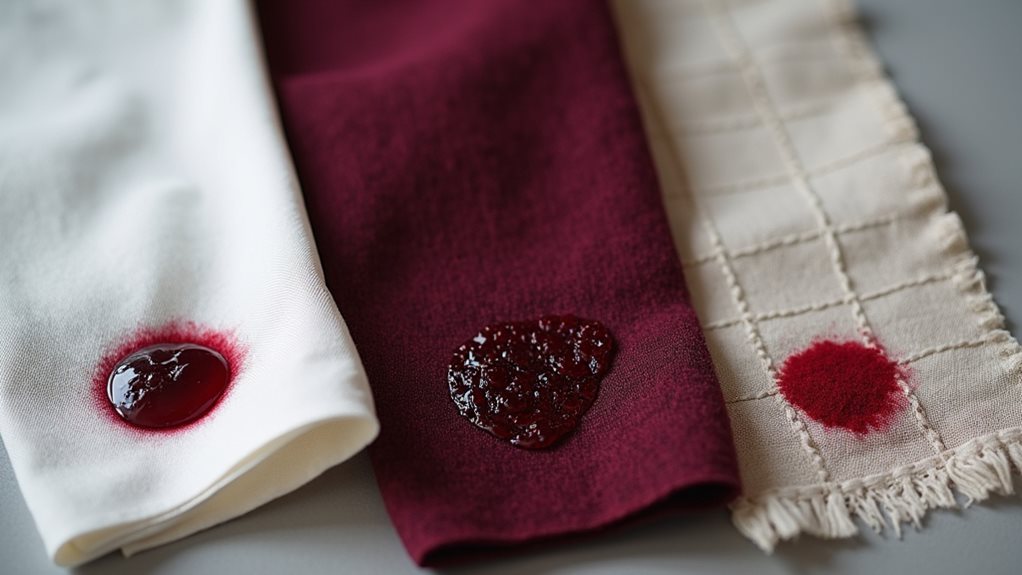
When you’re staring at that dreaded blood stain on your favorite shirt, you’ll be relieved to know that natural fibers like cotton, wool, and linen are your best friends in the dry cleaning world, since they can handle those powerful enzyme treatments without throwing a fabric tantrum.
Your synthetic pieces, like that polyester blouse you love, need a gentler touch because they’re basically drama queens when it comes to heat and aggressive solvents.
Those precious silk scarves and delicate materials require what I call the “white glove treatment” – specialized techniques that whisper the stain away rather than shouting at it with harsh chemicals.
The key to success with any fabric type is working with professional expertise that can identify the specific blood stain characteristics and apply the most appropriate treatment method for your particular garment.
Delicate Natural Fibers
After ruining my favorite silk blouse with a DIY hydrogen peroxide experiment gone wrong, I learned the hard way that delicate natural fibers like silk and wool demand the specialized touch that only professional dry cleaners can provide.
When you’re dealing with protein-based stains like blood on these precious fabrics, you’ll want to resist the urge to tackle them yourself.
Dry cleaners use enzyme-based solutions specifically designed to break down blood proteins without compromising your fabric’s integrity, and their advanced methods with non-water solvents like perchloroethylene work wonders where home remedies fail.
Professional dry cleaning excels at preventing discoloration while preserving texture and color—something my poor blouse could’ve benefited from! 😅
The chemical solvents used in dry cleaning dissolve protein-based stains more effectively than water-based washing methods, making them particularly suitable for delicate fabrics that could be damaged by traditional home cleaning attempts.
Trust me, your silk scarves will thank you.
Synthetic Fabric Treatment
Synthetic fabrics like polyester, nylon, and acrylic actually make your dry cleaner’s job considerably easier when it comes to blood stain removal, and honestly, I wish I’d known this during my clumsy college years when I seemed to bleed on everything!
Unlike natural fibers that absorb deeply, synthetic fabrics resist penetration, giving professional dry cleaning a real advantage.
Here’s why dry cleaning can remove blood stains so effectively from synthetic materials:
- Enzyme-based solutions break down protein-based stains without damaging durable synthetic fibers
- Specialized solvents target blood proteins while preserving fabric integrity completely
- Quick professional treatment prevents stains from setting permanently in non-absorbent synthetics
- Chemical resistance allows dry cleaners remove stains using stronger solutions for complete removal
Your synthetic workout clothes and polyester blouses have better survival odds! 🙌
The success of blood stain removal also depends on factors such as how long the stain has been present and whether any previous treatment attempts have set the stain permanently.
Specialty Material Considerations
Although I’ve learned this lesson through countless wardrobe mishaps over the years, understanding which specialty materials respond best to professional blood stain treatment can literally save your most treasured garments from permanent damage.
When you’re dealing with delicate fabrics like silk scarves or cashmere sweaters, professional cleaners become your fabric whisperers, using specialized hydrocarbon solvents that won’t compromise those precious fibers.
I’ve watched my favorite wool blazer emerge spotless after what I thought was certain doom 😅.
These materials require gentle coaxing rather than aggressive enzyme treatments, and honestly, attempting to remove blood stains yourself often backfires spectacularly.
Professional dry cleaners excel at treating blood stains on specialty fabrics because they use specialized solvents like perchloroethylene that can effectively break down protein-based marks without damaging delicate fibers.
Trust me, investing in professional cleaning for specialty materials isn’t just smart—it’s crucial insurance for preserving your wardrobe’s most valuable pieces.
When Blood Stains Cannot Be Completely Removed Through Dry Cleaning
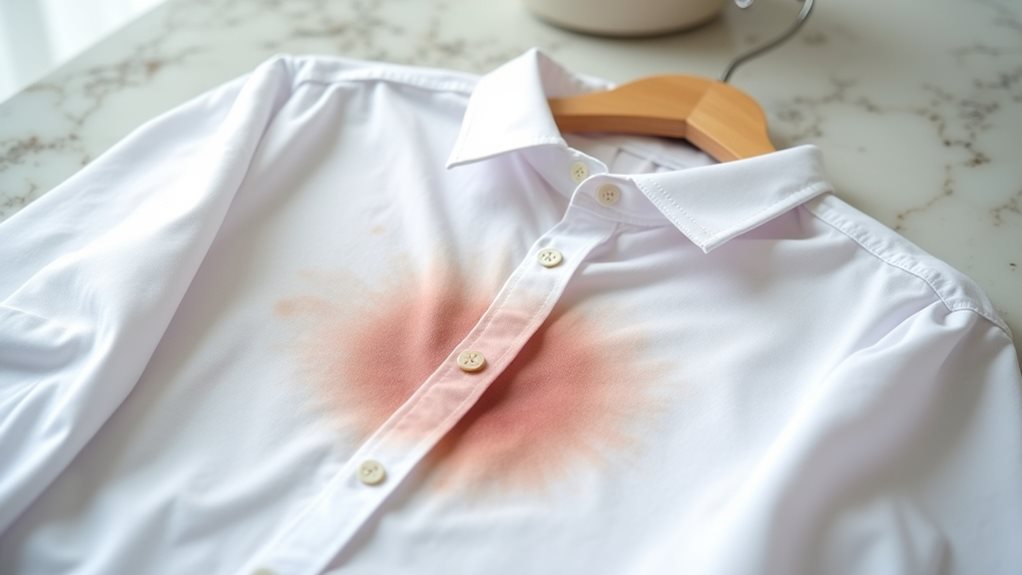
While dry cleaning works wonders on fresh blood stains, there are times when even the most skilled professionals can’t completely erase every trace of what happened.
When stains set deeply into fabric fibers, the cleaning process faces real limitations, especially with delicate fabrics that can’t handle aggressive treatments.
Here’s when blood stains resist complete removal:
- Old, set-in stains that have bonded permanently with fabric fibers over months or years
- Heat-damaged stains where someone tried to remove at home using hot water first
- Delicate fabrics like silk or vintage materials that limit stain removal techniques
- Large, saturated stains where blood penetrated multiple fabric layers
Even professional cleaners can only lighten these stubborn marks, not make them disappear entirely.
Sometimes life leaves permanent reminders! 😅
Steps to Take Before Bringing Blood-Stained Items to the Dry Cleaner

When disaster strikes and blood finds its way onto your favorite garment, the steps you take in those crucial first moments can make the difference between salvaging your item and saying goodbye to it forever.
Act quickly by rinsing the stained area with cold water, because heat will cause those stubborn blood proteins to bond permanently with your fabric fibers.
Speed is everything when blood hits fabric—cold water breaks down proteins while heat locks them in permanently.
Gently blot blood stains with a clean cloth, resisting the urge to scrub frantically—trust me, I’ve learned this lesson the hard way!
When you visit your dry cleaner, provide detailed information about the stain’s age and type of fabric involved.
Avoid using hot water or household remedies beforehand, as these well-intentioned efforts can actually complicate professional treatment and make it harder for experts to treat stains effectively.

